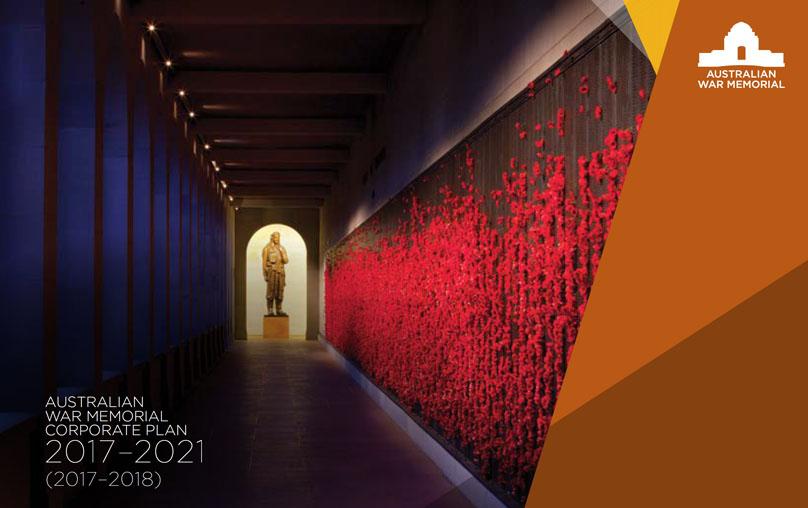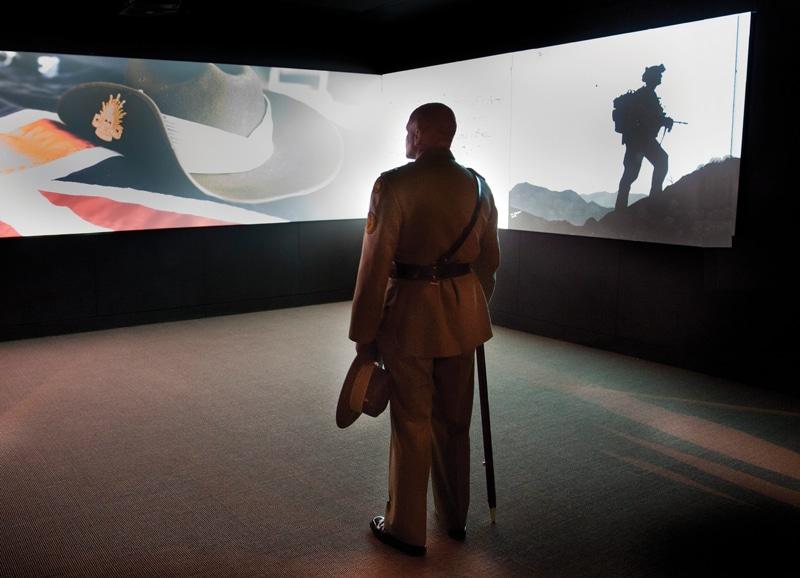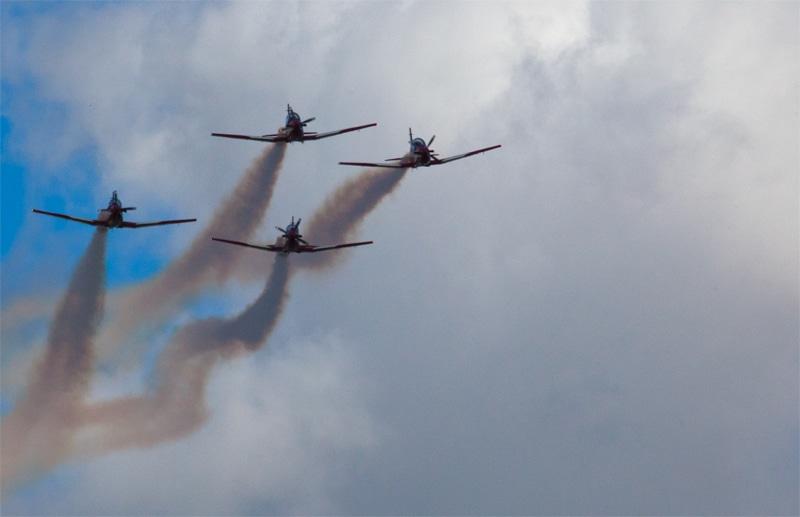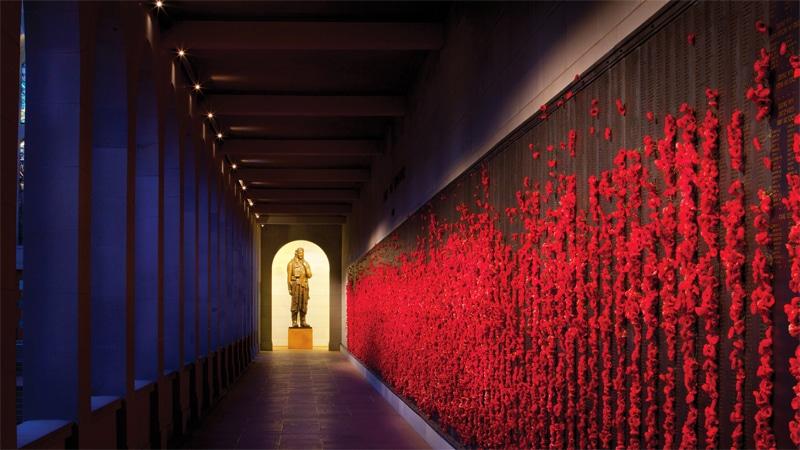Corporate Plan 2017-2018

The Commemorative Area showing the projection of the Roll of Honour names.
AUSTRALIAN WAR MEMORIAL Corporate Plan
2016—2020 (2017—2018)
Copyright 2017 © Australian War Memorial
ISSN 1441 4198
This work is copyright. Apart from any use as permitted under the Copyright Act 1968, no part may be reproduced, copied, scanned, stored in a retrieval system, recorded, or transmitted in any form or by any means without the prior written permission of the publisher.
Australian War Memorial
GPO Box 345
Canberra, ACT 2601
Australia
www.awm.gov.au

Warrant Officer David Ashley OAM, Regimental Sergeant Major, views the video display included in Afghanistan: the Australian story.
TABLE OF CONTENTS
STATEMENT OF PREPARATION
PURPOSE
MISSION
VISION
STRATEGIC PRIORITIES
1 Commemoration
2 Creating and sharing knowledge, expertise, and the National Collection
3 Increasing partnerships and organisational sustainability
4 Building the Memorial
ENVIRONMENT
LEGISLATION
PERFORMANCE
OUTCOME
1 Commemoration
2 Creating and sharing knowledge, expertise, and the National Collection
3 Increasing partnerships and organisational sustainability
4 Building the Memorial
MEASUREMENT
CAPABILITY
RISK OVERSIGHT AND MANAGEMENT
AUSTRALIAN WAR MEMORIAL Corporate Plan
2016—2020
(2016—2017)
STATEMENT OF PREPARATION
I, Brendan Nelson, Director of the Australian War Memorial, present the 2016–2020 Australian War Memorial Corporate Plan, as required under subsection 35(1) of the Public Governance, Performance and Accountability Act 2013. The plan is prepared in accordance with the Public Governance, Performance and Accountability Act 2013 for the 2016–17 reporting period. It covers the reporting periods from 2017-18 to 2019–21.
The Australian War Memorial combines a shrine, a world-class museum, and an extensive archive. Its purpose is to commemorate the sacrifice of those Australians who have died in war and operational service or who have served our nation in times of conflict. Its mission is to assist all Australians to remember, interpret, and understand the Australian experience of war and its enduring impact on Australian society.
This Corporate Plan details the focus of the efforts of the Council and staff of the Australian War Memorial in presenting to all Australians the service and sacrifice of those whose dedication for our freedoms and the hope of a better world, will never be forgotten.
Dr Brendan Nelson Director Australian War Memorial
PURPOSE
The purpose of the Australian War Memorial (the Memorial) is to commemorate the sacrifice of those Australians who have died in war or on operational service and those who have served our nation in times of conflict.
MISSION
To assist Australians to remember, interpret, and understand the Australian experience of war and its enduring impact on Australian society.
VISION
Our vision is for the Memorial to:
- play the leading role in the nation’s commemoration of the Australian experience of war;
- engage with people and communities to achieve our purpose;
- collaborate with a wide range of stakeholders and partners to create mutual long-term value; and
- be a workplace that inspires integrity and excellence.
STRATEGIC PRIORITIES
The Memorial’s key priorities are:
- Commemoration
- Creating and sharing knowledge, expertise, and the National Collection
- Increasing partnerships and organisational sustainability
- Building the Memorial
ENVIRONMENT
LEGISLATION
The Memorial is established as a corporation by the Australian War Memorial Act 1980 (the Act). The functions and the powers of the Memorial, the Minister, the Council, the Chair, and the Director are outlined in the Act.
The Memorial is also subject to a number of Acts of Parliament, including:
- the Public Governance, Performance and Accountability Act (2013), which governs the performance and accountability of Council and management, and imposes key reporting, financial, and pecuniary obligations on the Memorial and Council;
- the Freedom of Information Act (1982);
- the Privacy Amendment (Enhancing Privacy Protection) Act 2012;
- the Work Health and Safety Act 2011; and
- the Environmental Protection and Biodiversity Conservation Act 1999.
The Memorial is accountable to the Minister for Veterans’ Affairs and has strong links to the Department of Veterans’ Affairs for budgetary purposes, appropriations, and grants.
The Memorial adheres to Australian accounting standards and financial reporting rules in the preparation of its financial reports, and follows the principles and better practice guides issued by the Australian National Audit Office (ANAO).
BUDGET AND FUNDING
The Memorial relies on annual appropriation from Government and revenue generated from other sources to meet its objectives. Government funding is subject to budgetary restrictions and can fluctuate depending on government policy and direction. The Memorial can seek to influence the level of government funding through the standard budgetary processes, but always operates within its allocated resources. This may mean adjusting planned activities or staffing requirements, or seeking to increase revenue generated from the private sector.
VISITATION
The Memorial has two sites, both of which are in Canberra, and collaborates with other cultural agencies both nationally and internationally.
The Memorial appeals to a worldwide audience, with annual visitation now consistently exceeding one million and growing. Of these, approximately one third were born overseas; and school children comprise around 150,000 of the Memorial’s annual visitation. Visitor satisfaction remains high, with the Memorial being named the number one landmark in Australia on TripAdvisor.
The Memorial identifies audience groups and specific needs through varied and dedicated visitor research and evaluation. Regular surveys are undertaken of visitors and the general public to assist the Memorial in better understanding the needs and interests of its stakeholders. These include surveys that evaluate our brand health and that collect information about the profile and visitor experience of our audience. Topic-specific surveys and targeted research are undertaken to feed into the development and assess the performance of exhibitions, events, and other activities.
PERFORMANCE
OUTCOME
The Memorial assists Australians to remember, interpret, and understand the Australian experience of war and its enduring impact by maintaining and developing the National Memorial and its collection and exhibition of historical material, commemorative ceremonies, and research.
1. Commemoration
Commemoration is as much a personal engagement as it is a national engagement with those who have served and sacrificed in war. The Memorial is in a unique position to engage in commemoration equally on a national scale and at a personal level, whether by telling a single, personal story of sacrifice or by engaging in contemporary and relevant ways with individuals who wish to commemorate that sacrifice.
This priority will be achieved through:
Commemorative ceremonies
Commemoration is as much a personal engagement as it is a national engagement with those who have served and sacrificed in war. The Memorial is in a unique position to engage in commemoration equally on a national scale and at a personal level, whether by telling a single, personal story of sacrifice or by engaging in contemporary and relevant ways with individuals who wish to commemorate that sacrifice.
This priority will be achieved through:
Interpretive services
Understanding of the Australian experience of war will be enhanced through the provision of interactive interpretation, including the delivery of innovative onsite, outreach, and online education and public programs, as well as special events.
In 2017-18 the Memorial will deliver a range of public programs and events for its visitors, including engaging curriculum-related school resources and education programs, embracing digital and online advancements, for use by teachers and students.
2. Creating and sharing knowledge, expertise, and the National Collection
The combination of authoritative scholarship, inquiry, and the material heritage in the National Collection gives the Memorial the capability to promote understanding of the Australian experience of war from the Boer War to the present day. Through our exhibitions, education and public programs, online programs, and collection projects we strive to deliver services that are relevant to contemporary audiences onsite, offsite, and online.
This priority will be achieved through:
The National Collection
The Memorial holds an outstanding National Collection of historical material with provenance related to Australia’s military history, and this will be developed, managed, preserved, and interpreted in such a way as to make it accessible.
In 2017-18 the Memorial will continue to develop its National Collection through the acquisition, donation and commissioning of items relating to Australia’s military history, including collecting from recent and current conflicts and operations including peacekeeping and some peacetime operations that add to the story of Australia’s military history and heritage.
Exhibitions
Outstanding permanent, temporary, and travelling exhibitions will be developed and maintained.
In 2017-18 the Memorial will continue to maintain and refresh its permanent exhibitions and develop new temporary and touring exhibitions to tell stories of the Australian experience of war that are not currently told within permanent exhibitions.
Research, information, and dissemination
The stimulation of an interest in and understanding of Australia’s military history will be achieved via the production of and dissemination in print, broadcast, and online media of articles, papers and presentations, conferences, and publications, and via historical research and dissemination of knowledge and understanding of Australia’s military history.
In 2017-18 the Memorial will continue to facilitate the understanding of Australian military history and the Australian experience of war through the facilitation of access to reading room facilities, an authoritative research enquiry service and exemplary online research facilities.
The Memorial’s commitment to the delivery of significant research projects will continue through the finalisation and publication of the Official History of Peacekeeping and Post–Cold War Conflicts and the continuation of the writing of the Official History of Australian Operations in Iraq, Afghanistan and East Timor.
3. Increasing partnerships and organisational sustainability
In responding to the changing economic and social environment, the Memorial will seek out new opportunities to work with partners to sustain our important work in commemorating service and sacrifice in war. Staff will be supported and encouraged to work more collaboratively across disciplines to deliver innovative outcomes and for emerging audiences, through an improved project management and leadership discipline.
This priority will be achieved through:
Promotions and community services
The Memorial will be promoted as an outstanding national institution and assistance will be provided to the community to help people understand its roles, activities, programs, relevance, and future.
In 2017-18 the Memorial will continue to explore opportunities for enhanced program deliver including a paid tours program, including audio tours. The Memorial will continue to enhance its public profile as the centre of national commemoration through innovative marketing and public relations programs, the implementation of a revised brand strategy, and enhanced visitor evaluation programs.
Visitor services
The Memorial will be promoted as an outstanding national institution and assistance will be provided to the community to help people understand its roles, activities, programs, relevance, and future.
In 2017-18 the Memorial will continue to explore opportunities for enhanced program deliver including a paid tours program, including audio tours. The Memorial will continue to enhance its public profile as the centre of national commemoration through innovative marketing and public relations programs, the implementation of a revised brand strategy, and enhanced visitor evaluation programs.
4. Building the Memorial
Investment in the Memorial’s public spaces and collection storage areas will underpin success in engaging with new audiences and sustaining relevance to our stakeholders. Similarly, investment in business and communications infrastructure will improve accessibility for and engagement by our visitors, users of our services, and clients, as well as the efficiency of our staff in managing our assets.
This priority will be achieved through:
The Memorial and grounds
The Memorial building and grounds will be conserved and developed as a dignified, moving, and impressive national memorial to Australians who served and died in war, warlike operations and peacekeeping operations.
In 2017-18 the Memorial will continue to develop its Master Plan to address existing and future exhibition, archive, and storage needs required to provide appropriate facilities to effectively tell the stories of the Australian experience of war for the next 100 years. The plan incorporates gallery development, site accommodation and storage, and the Campbell and Mitchell precincts.
MEASUREMENT
In addition to its significant commemorative nature, the Memorial is a public institution and tourist attraction. In this regard visitors onsite, offsite, and online are paramount to the performance of the organisation. A number of performance and satisfaction measures are obtained through quantitative and quantitative methods. These methods include:
- automated and manual quantitative visitor counts in various gallery locations throughout the museum and in ceremonies and activities externally;
- visitor surveys with a broad range of visitors throughout the year;
- in-depth qualitative surveys with visitors; and
- surveying of website visitors.
Data is collated daily, monthly, quarterly, and annually on a range of services and operations delivered by the Memorial that support and assist visitors and users of the National Collection as well as the housing, preservation, and maintenance of the National Collection and the Memorial buildings.
This analysis guides the organisation’s key performance indicators, including visitor attendance, public interactions and service provision, productivity of maintenance, stewardship of the National Collection, and safety of staff and visitors.
Program elements that are not able to be measured in a quantitative manner are done so qualitatively, either through feedback from stakeholders and the public, or through the professional judgment of Memorial staff.
CAPABILITY
The Memorial maintains a range of key strategies and plans to achieve our purpose:
- Master Commemorative Anniversary Plan, providing the framework within public commemorative ceremonies to address all significant anniversaries.
- Public Engagement Strategy, to develop and implement public engagement activities through multiple communication methods from exhibitions and publications to audio-visual and web- and mobile-based offerings. This provides opportunities to make the Memorial’s content, whether interpreted or direct, available to be shared, further interpreted, or reused by our stakeholders.
- Reconciliation Action Plan, facilitating the Memorial’s engagement and reconciliation with Australian Indigenous people. The Memorial’s Indigenous Liaison Officer works actively with Indigenous nations to ensure that commemorative activity is respectful to the traditional owners of the land.
- Australian War Memorial Master Plan, allowing a single scope to provide an interdependent view across the linked key organisation priorities of informing future public use, gallery planning, building operation, and accommodation and storage requirements, alongside the hospitality needs of visitors.
- Digitisation Strategy, integrating conservation processes and online delivery of content related to the National Collection as well as allowing the effective delivery of centenary projects, addressing at-risk collections through the creation of surrogates or preservation copies, and undertaking a program of 3D or 360-degree photography of the interiors of Large Technology Objects for conservation assessment and online delivery.
- Conservation Strategy, ensuring the National Collection is conserved to appropriate standards, including:
- assessment and reconfiguring of storage conditions for optimal effectiveness in conservation;
- upgrading of plant and equipment where needed;
- implementing of processes to effectively manage acquisitions through to storage;
- prioritisation for at-risk collection items;
- development of risk-mitigation strategies for at-risk, vulnerable, and high-use collection items;
- provision of digital content to the web;
- andlinks with public programming.
- Collection Development Plan, identifying:
- approaches for collecting from contemporary operations and the changing nature of conflict;
- themes for collection and research development, including contemporary responses to war in a more culturally diverse Australian society;
- opportunities for financial and in-kind support for collection development activities;
- opportunities for collaboration in collection development, interdisciplinary research associated with the collection, and engagement in our region on the Australian experience of war;
- opportunities to streamline the processes for acquisition by donation in accordance with the Service Charter; and
- gaps in the collection in areas of high priority for public programs, research, or public interest.
- Web and Digital Experience Strategy, including an engaging website and digital platforms with accurate information and a strong social media aspect allowing visitors to review, discover, and research information and the Memorial’s collections in an integrated manner (including online sales), as well as providing high-quality service to the media.
- Communications and Marketing Plan, identifying the brand messages, activities, and channels through which to position and promote the Memorial, including public relations and social media positioning.
- Sponsorship and Partnership Strategy, including the framework to effectively generate and maintain new and existing relationships with sponsors and partners. This strategy includes financial targets to frame the program and define new income-generation opportunities, in addition to a program for the appropriate recognition and acknowledgement of sponsors and partners.
- Workforce Planning Strategy, including the management of staff resources to optimise operations and program delivery, and the management of broad workforce capability requirements ranging from administration, facilities management, and corporate governance skills to specialist conservation, curatorial, and event management skills. Management of workforce supply will be undertaken in line with government policy and available resources.
- Staff Development Plan, encompassing ongoing learning and professional development of the Memorial’s workforce, including facilitating an organisation-wide project management and leadership discipline, building staff capability in delivery through new channels and information dissemination to new audiences, and encouraging staff to embrace innovation in the delivery of the Memorial’s mission.
- Enterprise Infrastructure Strategy, ensuring oversight and integration of all Information and Communications Technology (ICT) infrastructure with corporate goals and priorities. This includes IT infrastructure maintenance and upgrading, collection management and storage requirements, audio-visual and gallery media, and corporate records, financial, and human resources management.
- Capital Investment Strategy, managing the challenges associated with storage requirements for the Memorial’s growing collection. Following the acquisition of the final property in its Mitchell precinct, the Memorial is continuing its long-term collection storage and accommodation plans through the review and updating of the Mitchell Site Master Plan. This plan will provide a long-term strategy to ensure the limited space is used effectively for increased collection storage and conservation facility needs, and will be implemented in a staged approach as capital resources allow.
The Memorial continues to invest in significant digitisation projects with the dual purpose of preserving collection material and improving access for both internal use and clients. These digitisation projects are backed by a comprehensive preservation-standard digital asset repository, which needs to be expanded on a regular basis in order to accommodate new material. Significant volumes of data being generated by the digitisation of film (which can no longer be preserved by film copying) will accelerate the need for additional expansion of the digital asset repository. The resource will also facilitate more timely and automated access to information and digitised materials.
The digital asset repository mentioned above not only needs to be expanded to accommodate new material but also needs a plan for its capital replacement based on a five-year life cycle. Despite some relief from the declining cost of technology, the capital outlay for system replacement continues to increase depending on the rate of overall growth in the total volume of data to be maintained, and this will be affected by the anticipated expansion in accordance with the Australian War Memorial Master Plan.
RISK OVERSIGHT AND MANAGEMENT
As a key management tool at a corporate level, risk management is an integral part of the Memorial’s corporate and business planning. Actions flowing from the Business Risk Assessment and the Fraud Risk Assessment are included in the annual Memorial Business Plan and associated Key Performance Indicators.
The Memorial applies sound risk management procedures in accordance with applicable risk management standards (refer ISO 31000:2009), the Commonwealth Risk Management Policy, and Comcover’s Better Practice Guide 2008.
At a corporate level, formal Business Risk Assessments and Fraud Risk Assessments are completed every three years in advance of revision of the Corporate Plan, or earlier if needed. The results inform the development of the next Corporate Plan, and actions are included in each annual Business Plan.
Allied to this, other associated plans (for example, Fraud Control, Business Continuity, and Disaster Recovery) are reviewed in accordance with the applicable Director’s Instruction. They also inform risk-assessment and risk-management planning.
Progress on agreed actions is reported as part of the quarterly business plan reporting process.
The Corporate Management Group (CMG) and Council receive regular reports on risks that are assessed as “moderate”, “significant”, “high”, “very high”, or “extreme”. In addition, the monitoring of risk is undertaken through a comprehensive system of incident reporting, which is scrutinised by CMG on a regular basis.

The RAAF Roulettes at the Australian War Memorial Open Day, April 2013.
Contact
Executive Officer
Corporate Services
GPO Box 345
Canberra
ACT 2601
Phone: 02 6243 4290
Fax: 02 6243 4330
Email: executive@awm.gov.au
Website: www.awm.gov.au

The Roll of Honour in the cloisters lining the Commemorative Area.
